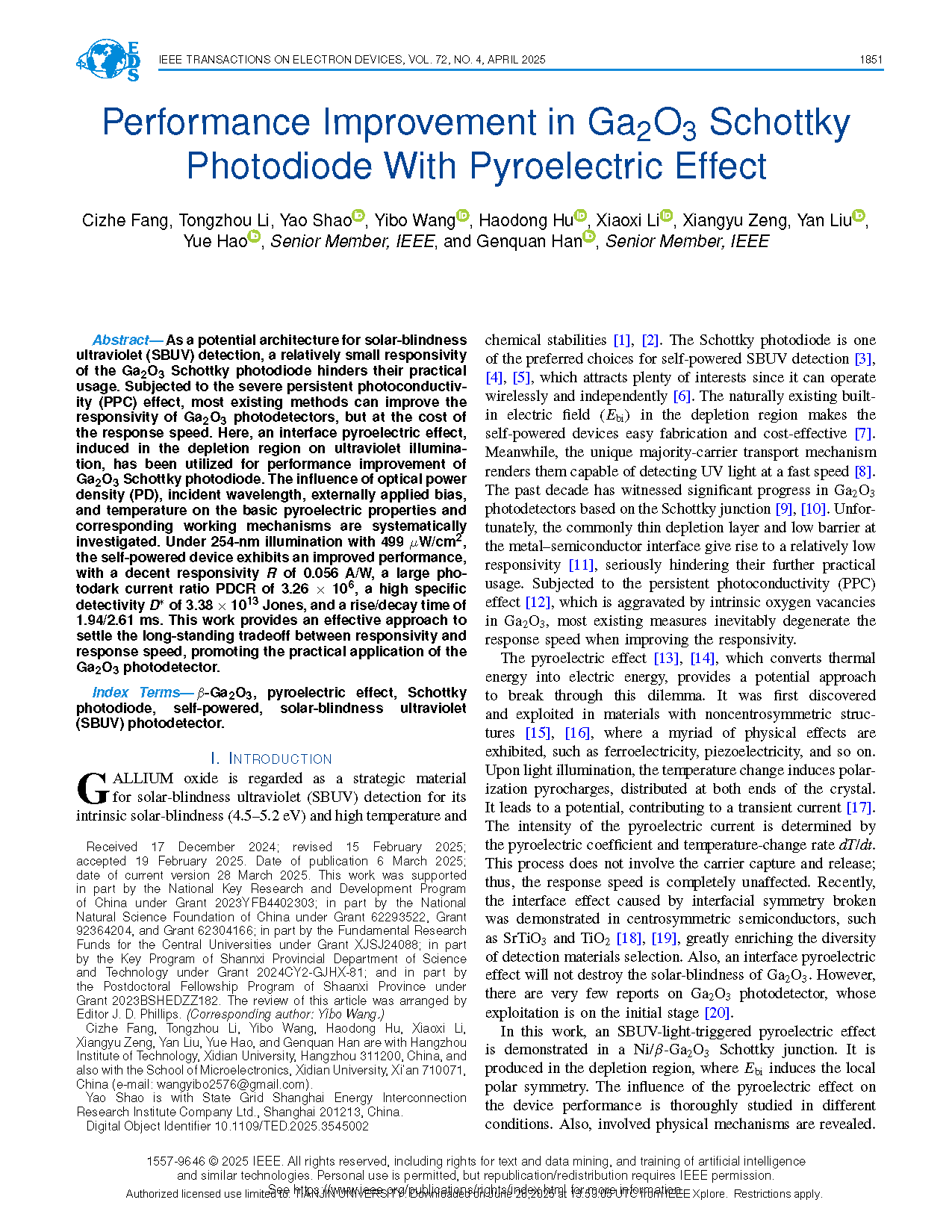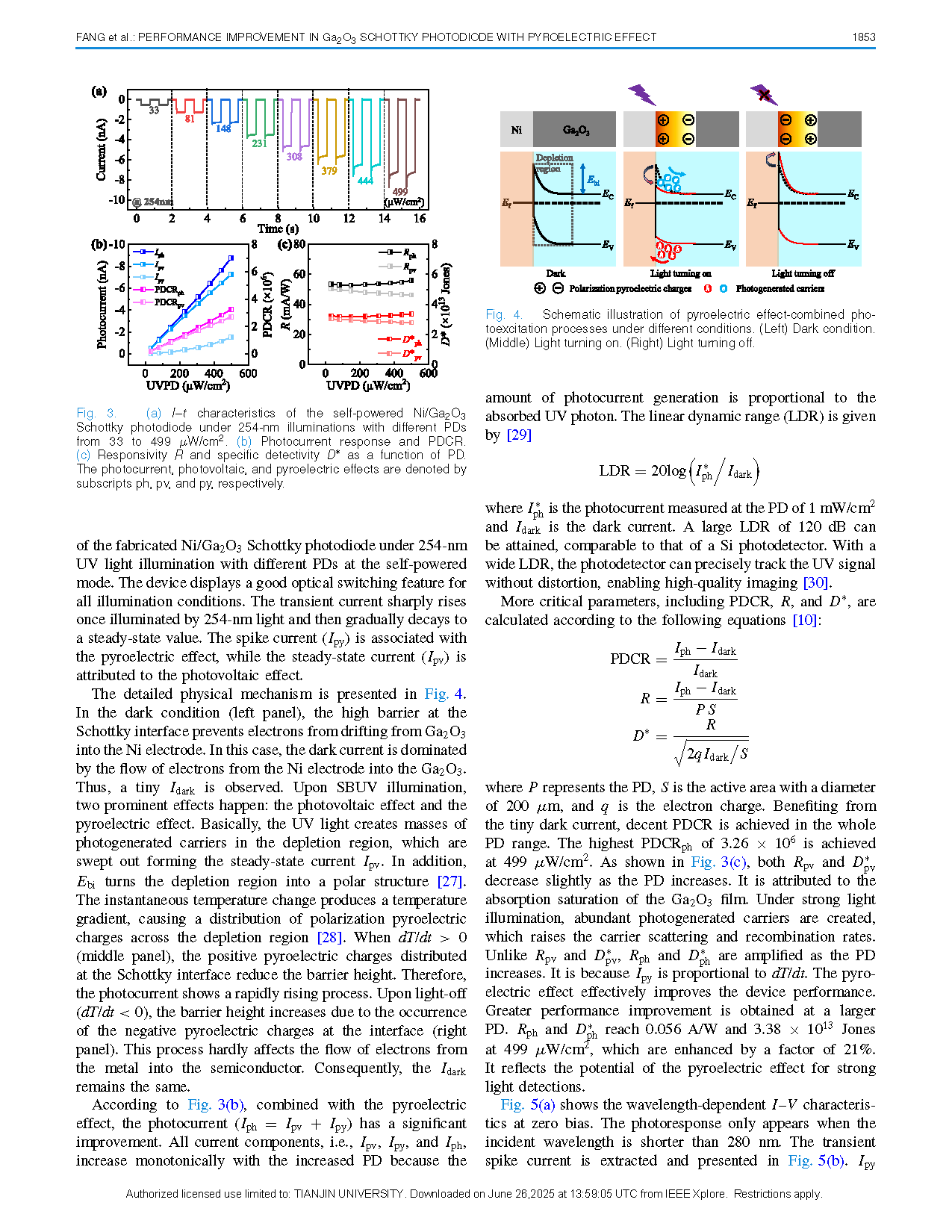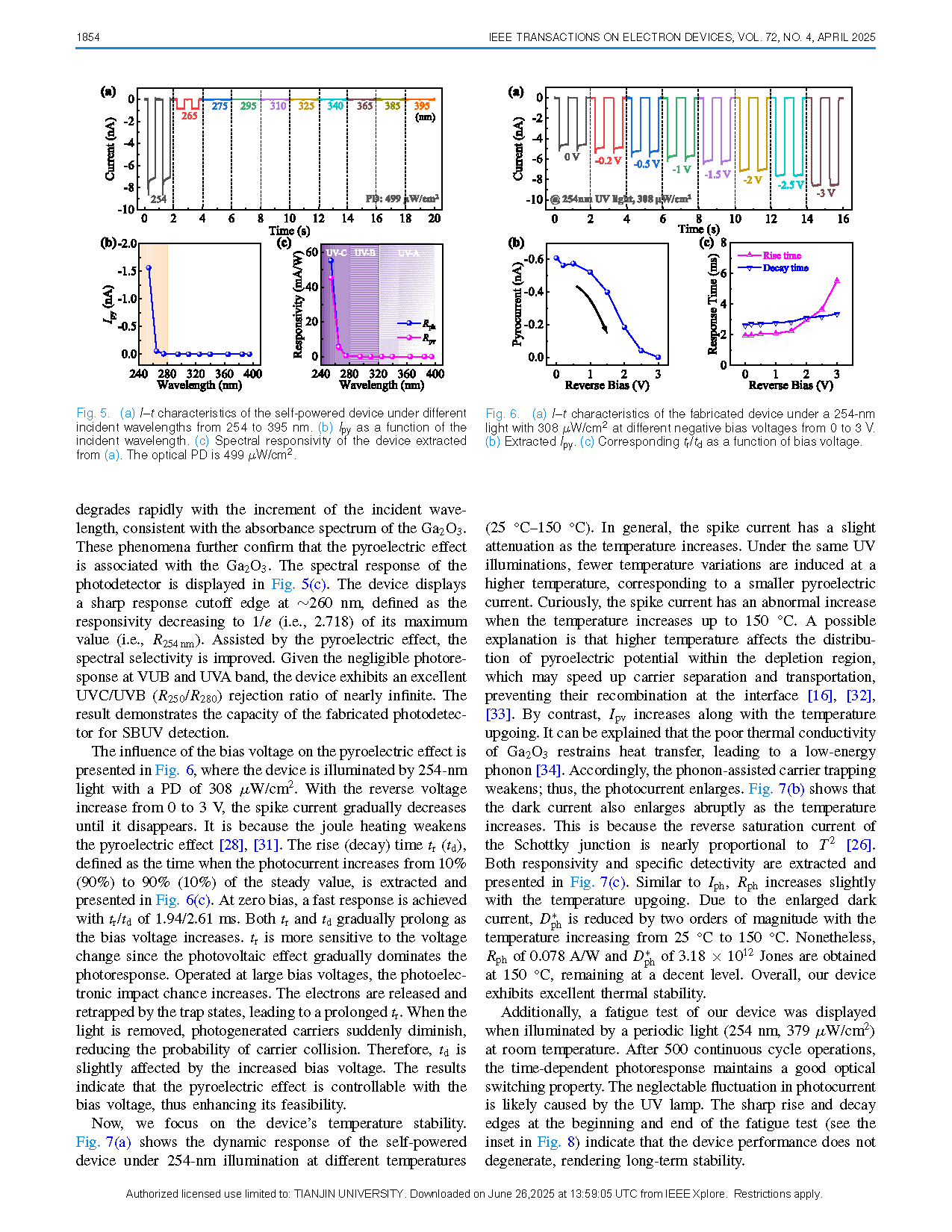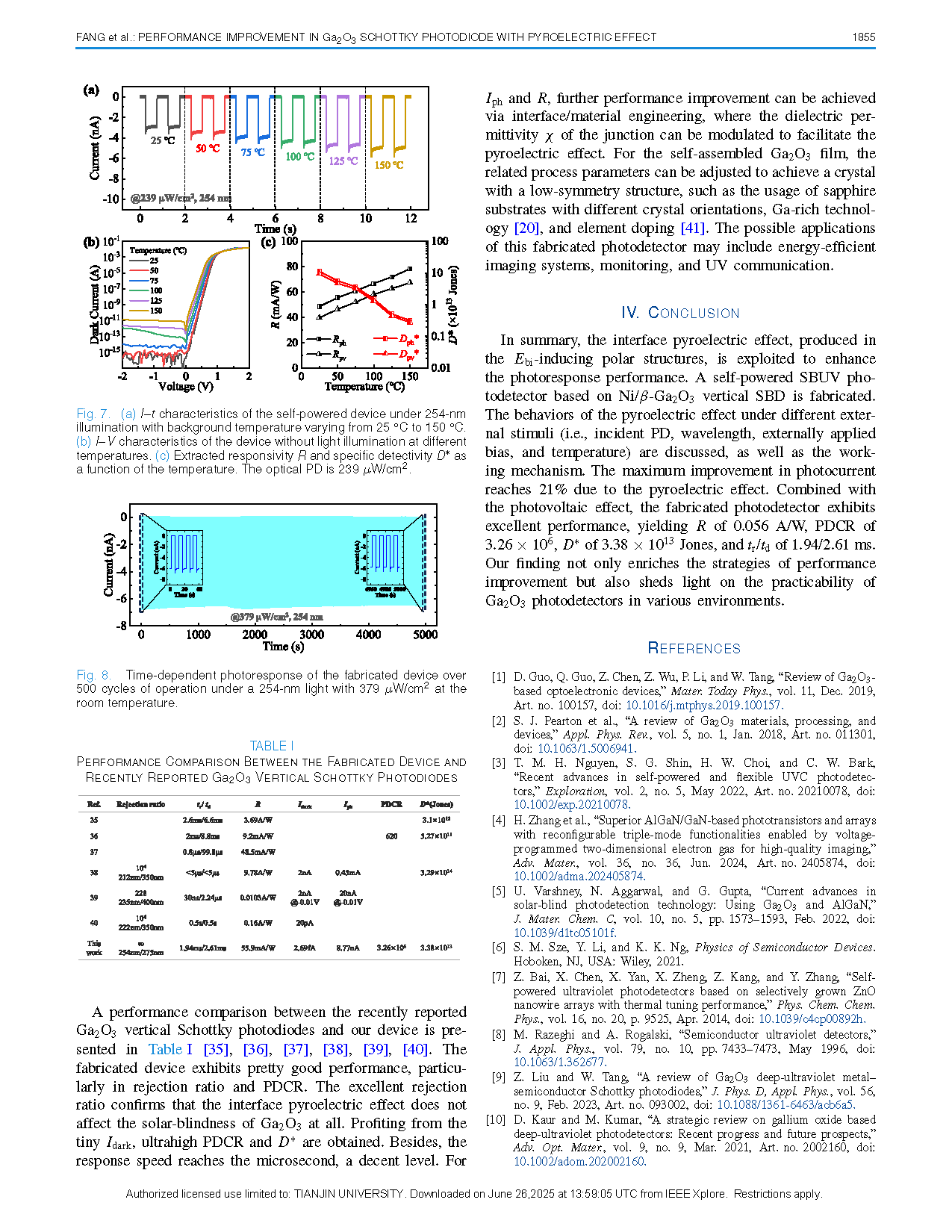
【Member Papers】Performance Improvement in Ga₂O₃ Schottky Photodiode With Pyroelectric Effect
日期:2025-07-10阅读:244
Researchers from the Xidian University have published a dissertation titled "Performance Improvement in Ga2O3 Schottky Photodiode With Pyroelectric Effect" in IEEE Transactions on Electron Devices.
Project Support
This work was supported in part by the National Key Research and Development Program of China under Grant 2023YFB4402303; in part by the National Natural Science Foundation of China under Grant 62293522, Grant 92364204, and Grant 62304166; in part by the Fundamental Research Funds for the Central Universities under Grant XJSJ24088; in part by the Key Program of Shannxi Provincial Department of Science and Technology under Grant 2024CY2-GJHX-81; and in part by the Postdoctoral Fellowship Program of Shaanxi Province under Grant 2023BSHEDZZ182.
Background
Gallium oxide is regarded as a strategic material for solar-blindness ultraviolet (SBUV) detection for its intrinsic solar-blindness (4.5–5.2 eV) and high temperature and chemical stabilities. The Schottky photodiode is one of the preferred choices for self-powered SBUV detection, which attracts plenty of interests since it can operate wirelessly and independently. The naturally existing built-in electric field (Ebi) in the depletion region makes the self-powered devices easy fabrication and cost-effective. Meanwhile, the unique majority-carrier transport mechanism renders them capable of detecting UV light at a fast speed. The past decade has witnessed significant progress in Ga2O3 photodetectors based on the Schottky junction. Unfortunately, the commonly thin depletion layer and low barrier at the metal–semiconductor interface give rise to a relatively low responsivity, seriously hindering their further practical usage. Subjected to the persistent photoconductivity (PPC) effect, which is aggravated by intrinsic oxygen vacancies in Ga2O3, most existing measures inevitably degenerate the response speed when improving the responsivity.
Abstract
As a potential architecture for solar-blindness ultraviolet (SBUV) detection, a relatively small responsivity of the Ga2O3 Schottky photodiode hinders their practical usage. Subjected to the severe persistent photoconductivity (PPC) effect, most existing methods can improve the responsivity of Ga2O3 photodetectors, but at the cost of the response speed. Here, an interface pyroelectric effect, induced in the depletion region on ultraviolet illumination, has been utilized for performance improvement of Ga2O3 Schottky photodiode. The influence of optical power density (PD), incident wavelength, externally applied bias, and temperature on the basic pyroelectric properties and corresponding working mechanisms are systematically investigated. Under 254-nm illumination with 499 μ W/cm2, the self-powered device exhibits an improved performance, with a decent responsivity R of 0.056 A/W, a large photodark current ratio PDCR of 3.26×106, a high specific detectivity D∗ of 3.38×1013 Jones, and a rise/decay time of 1.94/2.61 ms. This work provides an effective approach to settle the long-standing tradeoff between responsivity and response speed, promoting the practical application of the Ga2O3 photodetector.
Conclusion
In summary, the interface pyroelectric effect, produced in the Ebi-inducing polar structures, is exploited to enhance the photoresponse performance. A self-powered SBUV photodetector based on Ni/β-Ga2O3 vertical SBD is fabricated. The behaviors of the pyroelectric effect under different external stimuli (i.e., incident PD, wavelength, externally applied bias, and temperature) are discussed, as well as the working mechanism. The maximum improvement in photocurrent reaches 21% due to the pyroelectric effect. Combined with the photovoltaic effect, the fabricated photodetector exhibits excellent performance, yielding R of 0.056 A/W, PDCR of 3.26 × 106, D ∗ of 3.38 × 1013 Jones, and tr /td of 1.94/2.61 ms. Our finding not only enriches the strategies of performance improvement but also sheds light on the practicability of Ga2O3 photodetectors in various environments.
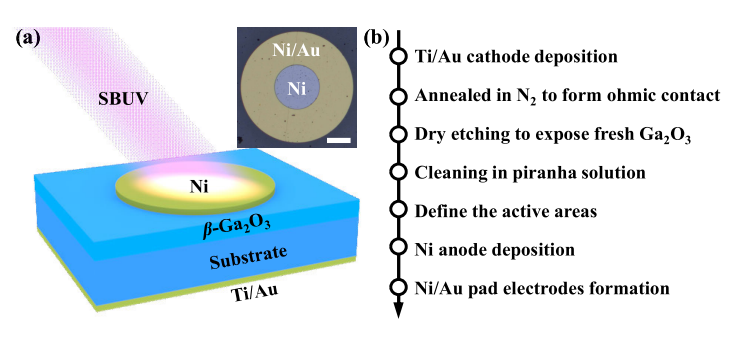
Fig. 1. (a) Sketch map of the self-powered SBUV photodetector based on a Ni/β-Ga2O3 vertical SBD. Inset: optical image of the fabricated device. The scale bar represents 100 µm. (b) Key process steps for fabricating the Ga2O3 Schottky photodiode.
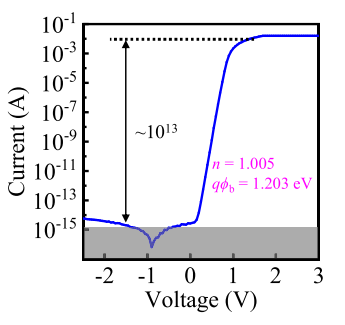
Fig. 2. Semi-logarithmic plot of the I–V characteristic for the fabricated device. The gray area is beyond the measurement range of Keithley 4200A-SCS.
DOI:
doi.org/10.1109/TED.2025.3545002
